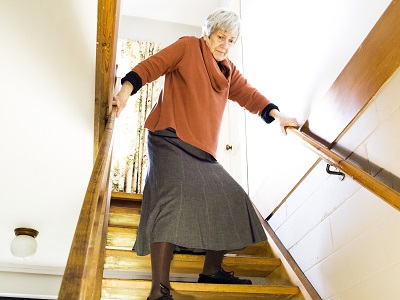When you think of someone needing a stairlift it’s easy to assume their biggest challenge is climbing up the stairs. After all, it always harder to climb up a hill than to coast down the other side, right?
For someone with a condition such as angina that would probably be the case. It can leave you breathless and in pain through physical exertion, so yes, climbing up the stairs would usually present more of a challenge than going down.
 But for many people, the bigger problem with stairs – and the bigger danger – is not going up, but coming down.
But for many people, the bigger problem with stairs – and the bigger danger – is not going up, but coming down.
More people buy an Acorn stairlift to help them cope with arthritis than for any other single reason. Arthritis is a common and usually (but not always) age-related condition which causes pain and inflammation in the joints. Particularly affecting the weight-bearing joints, such as hips, knees and ankles, arthritis can make moving around difficult, slow and painful.
For people with arthritis, and similar ‘musculoskeletal’ conditions, climbing up the stairs is certainly a challenge, but it can usually be achieved fairly smoothly by moving at a slow and measured pace, and using one or two banister rails to steady yourself and pull yourself up. Another helpful and often necessary technique is ‘single stepping’ – placing one foot on a step then bringing the other foot up to join it on the same step before repeating the process, taking just one step at a time.
In sharp contrast, coming down the stairs is much more likely to ‘jolt’ painful joints with every step. Having less muscle strength means the body is also less able to absorb or cushion these sudden and painful jolts.
Some people with these kind of mobility problems find it easier and less painful to descend the stairs backwards – using the same technique as going up, but in reverse. Others try to go down sideways, perhaps with their back to the banister and holding onto it with both hands for better support.
The trouble is that none of these ways is particularly safe. Descending in the ‘normal’ way, with a jolt at every step, leads people to fear their joint’s or muscles will ‘give way’ as their weight transfers suddenly to the leg on the next step down. Coming down backwards means you can’t see what’s behind you and placing your feet is a matter of feeling for each step. Coming down sideways is possibly the worst in terms of putting unusual strain on muscles and joints; the human body simply isn’t designed to move sideways, especially when climbing or descending.
A banister rail can offer only limited support when going down, although having a second banister installed on the opposite side might help if your stairs are narrow enough, providing equally balanced two-handed support. Using walking sticks or crutches is also tricky on the stairs, as they are set at the right height to help you walk on a level surface.
Statistics suggest that falls when coming down the stairs are more common than going up, although it could just be that more ‘descending falls’ are recorded in official statistics. Why? Because the consequences are likely to be much more serious, requiring official intervention by health services.
If you trip and fall climbing the stairs, chances are you will fall forwards onto the stairs. You might then slide down on your front and, while unpleasant, the experience will probably be less traumatic, physically if not emotionally. Falls descending the stairs come in two main types; firstly, your feet could slip from under you, especially is your carpet is loose or worn or your footwear is unsuitable. If this happens you are likely to fall backwards onto the stairs and come bumping down on your back or bottom, with little chance of halting your descent.
This is bad enough, but not as bad as tripping or being let down by your body and then falling forwards into thin air. In this situation, the consequences really don’t bear thinking about. In short, however it happens, the one thing you need to avoid is falling on the stairs. Any fall can be serious, but a fall on the stairs can be catastrophic.
If you’re concerned about your safety (or that of a loved one) on the stairs, an Acorn Stairlift can take that worry away. It enables you to travel smoothly both up and down the stairs, in comfort and safety. No more pain and, crucially, no more danger of falling.
Too often we end up installing a stairlift for someone after they have suffered a fall on the stairs. We would much rather do it before that happens because, as with any health measure, prevention is always better than cure. An Acorn Stairlift can be installed quickly, with no mess or structural alterations, and will probably cost less than you think.
Why not book a free, no-obligation home survey to find out how an Acorn Stairlift can eliminate the potential danger of a fall on the stairs? Call us on 0808 223 4871 or click on the green ‘Quick Free Quote’ button at the top right of this page to get the ball rolling.
